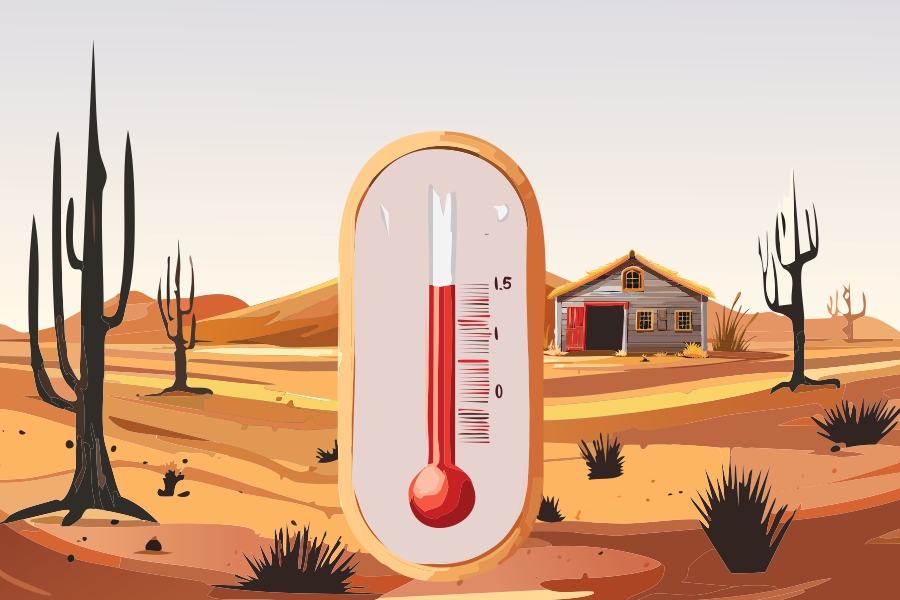In January uncontrolled wildfires ripped across California, reducing entire neighborhoods to cinders. Even further, last July the world set the hottest global temperature on record, which it held for three days in a row before breaking on the fourth day.
“Starting in February of 2023, each month has had on average an increased temperature of around 1.5 degrees Celsius,” SMU climate professor Robert Gregory said. “In fact, September of 2023 was the hottest September the globe has ever experienced.”
1.5 degrees Celsius is not just a random number relating to climate, it is the temperature set by the Paris Climate Agreement back in 2016. The agreement set the goal of reducing climate change before the average temperature of each month exceeded 1.5 degrees Celsius (2.7 degrees Fahrenheit) above pre-industrial temperatures.
“These extreme weather events are mainly a consequence of climate change driven by humans’ continued burning of coal, oil, and natural gas,” professor of environmental law Jeffery Lowes said. “Climate scientists agree that extreme weather such as what people experienced this summer will likely grow more frequent and intense in the coming years unless something is done, on a persistent and planet-wide scale, to rein in global temperatures.”
The effects of climate change has yet to to be fully realised, and scientists are still discovering the impact that it will have on our environment. In the past couple decades, the list of climate effects has expanded from simple global warming to a litany of disasters such as far more powerful hurricanes, worse wildfires, droughts, and tsunamis.
“The common perception of global warming is that the temperatures will obviously get warmer, but that is only true on a global scale,” Gregory said. “The truth is that things are just becoming more extreme. The melting of ice caps in the Northern and Southern Poles are leading to the destabilization of cold winds and weather patterns, causing them to be more severe, and reach areas they don’t usually, such as Texas.”
The reason 1.5 degrees was chosen out of all possible landmarks for global warming was not that it was a randomly selected article. First, it was an identifiable, easily understandable number, just asking how much the average temperature increased. For the second, other forms of climate change, such as melting glaciers and increased hurricane power are more difficult to depict in a simple and accurate measure.
“The reason why melting glaciers is always such a large focus and point of conversation is because those are truly irreversible,” Lowes said. “We can’t just make more glaciers, it’s not possible, nor is it pragmatic.”
Not only will the weather become more unstable and extreme, but global currents will begin to break down. Global currents are a large factor in controlling the weather of coastal areas. When cold water enters warmer water, the cold water sinks, causing the currents. With the temperatures warming rapidly, these currents may slow or even stop.
“The earth, in a nutshell, has areas where the winds follow a nearly regular pattern due to their temperature,” Texas A&M hydrology professor Shankar Chellam said. “There are much cooler areas in the north and south, that send out cold winds to spread with the rest of the world. When glaciers melt, the equilibrium is disturbed. Areas that are supposed to be warm get cold weather and the areas that are supposed to be cold get much hotter weather.”
The earth is a very self-reliant system according to the Intergovernmental Panel on Climate Change. Even events that occur on opposite sides of the earth within opposite systems still affect each other in real and important ways. When glaciers melt in the north, countries thousands of miles away either don’t get enough rain or get a disastrous monsoon. The careful balance our planet has walked for centuries is starting to tip.
“Not only is the temperature a worry, but the water levels, ” Chellam said. “Many islands are already starting to be swallowed up by the water pouring in that has previously been frozen for thousands if not millions of years. The Maldives, Kiribati, and Tuvalu are all at risk of being consumed by the ocean.”
In these areas, there is far too much water while others may see far too little. Another factor of climate change often presents itself through droughts. Due to the higher temperatures, soil dries out significantly quicker. Not only does the soil lose water faster, but the increased temperature often causes weather patterns to restrict rain in certain areas, causing some of the worst droughts we have seen for a long time. Climate change will overall make every aspect of the human condition far more difficult. Weather, storms, food supplies, and water levels will all start falling into the extremes.
“This temperature checkpoint is our last chance,” Gregory said. “Over the past few decades, we have made estimates of how difficult it would be to reduce our emissions and patch up the ozone layer before they make an irreversible impact. From where we stand right now at 1.5 degrees, this is our last chance to realistically be able to save the planet and the billions of people that inhabit it.”





